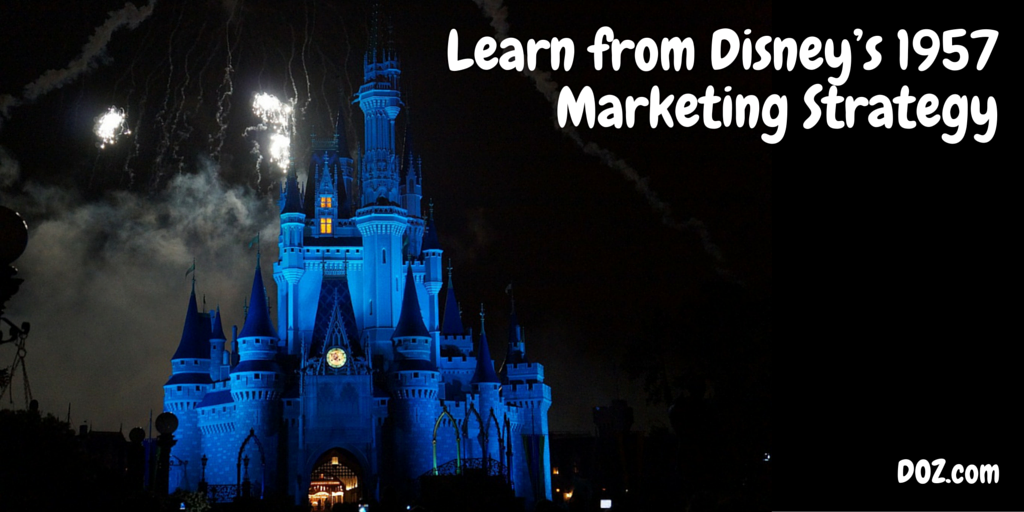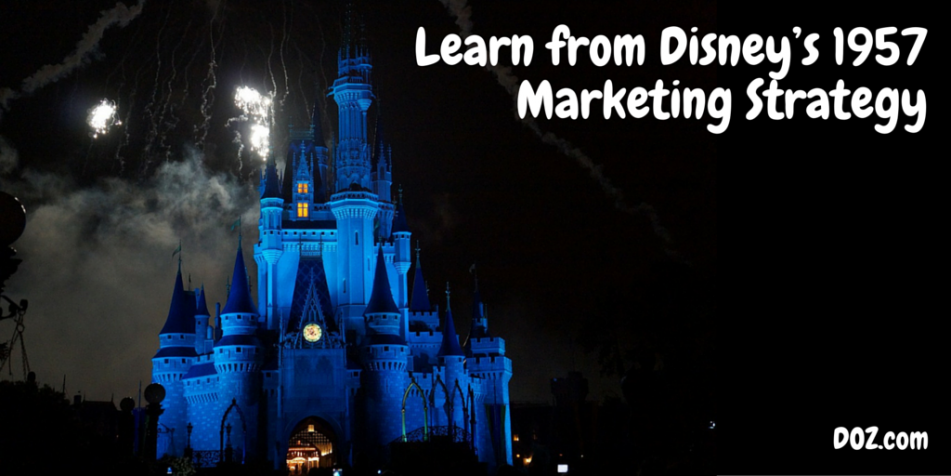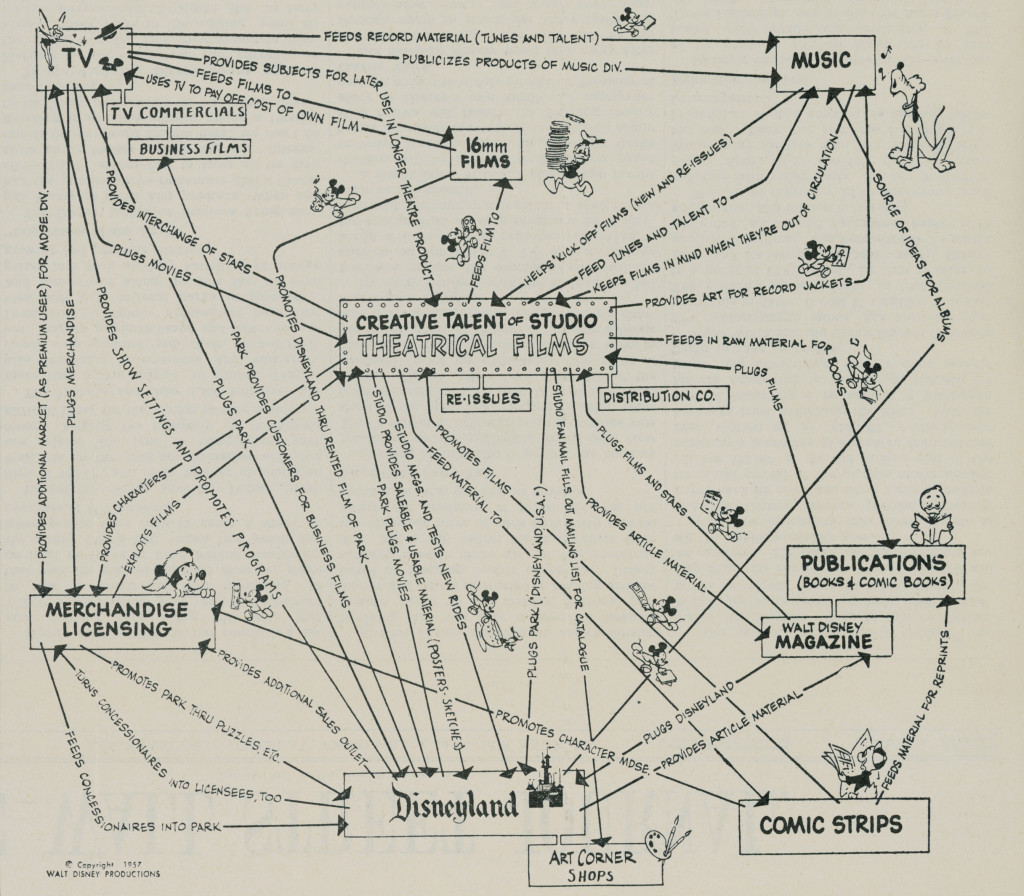
In a world where we talk about the values of tweets, engagement rates on Facebook, viral videos on YouTube, loops on Vine, and advertising on mobile devices, is there anything for the modern digital marketer to learn from a 60-year-old marketing strategy?
Short answer: yes.
In this post we’ll be taking a look at Disney’s marketing strategy from back in 1957 and explaining the different elements, the way they work together, and the way that digital marketers can apply Disney’s decades-old model to their digital marketing campaigns in the present day.
The Disney Strategy
At first glance it is something approaching a flowchart or a very basic infographic. But what it really is is a marketing strategy that is applicable today as it was in the 1950s when it was developed.
Let’s unpack the elements in the image.
At the center of the strategy are Disney’s Theatrical Films. They are what Disney is best known for and the basis for the rest of Disney’s business. Whether classics like Snow White and the Seven Dwarves or Dumbo, or in more recent years the collaborations with Pixar or in-house global hits like Frozen, these are the first things that people associate with Disney.
Other key elements in the Disney strategy are represented in the boxes surrounding the Theatrical Films centerpiece.
In the top-left corner there is TV, with associated elements like TV Commercials and Business Films also parts of the Disney plan. Moving clockwise, next comes Music and then Publications. The latter includes both the books and comic books that feature Disney characters as well as the Walt Disney Magazine that highlights the entire company.
Next are the Disney Comic Strips. These would be published not only in the company’s comic books but also in newspapers across the US and, eventually, the world. There’s also Disneyland, the company’s eponymous theme park and resort (at the time there was only one park) where Disney characters dominate the entertainment and attractions.
Finally, there’s Merchandise Licensing, the final key in the Disney marketing and revenue generation strategy. If this was important in the 1950s it is even more so today: as Bloomberg reported, Disney expected to record $734 million in US ticket sales for the most recent Star Wars film, a figure dwarfed by the $5 billion it expected in merchandise sales.
With the elements outlined, let’s look at some of the ways these elements work together as part of a coherent strategy.
Interlocking Elements
To demonstrate how the different elements in the Disney strategy work together we can follow a hypothetical Disney film from the center of the strategy through the other elements of the strategy.
So consider a new Disney film based on adventures at the world’s leading marketing marketplace and SaaS solution for businesses: The DOZ Story.
Hey, we can dream, right?
So Disney develops a feature film and, when the musical score if produced, it gets pumped up by Disney’s music division. The music division will promote the songs from the movie – Let it Go, anyone? – and drive further interest in the movie either as a new or a re-release.
The movie is released on 16mm film (today that would be digital, of course) which is fed into television, too. The TV division will produce commercials to support the film and promote it to audiences, and may even use the characters from the film in corporate promotions, too.
Of course, the TV support will help drive the merchandising of the movie. Disney will license almost any product in support of the film and so t-shirts, coffee cups, beach towels, and posters will be produced in the millions to drive fans to spend up in Disney stores and affiliated retailers, and to drive even further interest in the film.
As the merchandising takes hold it’s on to Disneyland. Life-sized characters can interact with children and adults alike in the theme parks, and rides and attractions can be developed to further capitalize on the film. The theme parks help Disney to generate revenues from a film long after it has disappeared from cinemas. Example? A Dumbo carousel, Snow White and her tiny co-stars leading a Main Street parade, and even Mickey Mouse driving engagement at Disney parks worldwide decades after he first whistled a tune in Steamboat Willy.
The Disneyland attractions and experiences around the movie will provide fresh content for the Walt Disney Magazine and the characters from the film can form the basis for a comic strip or a comic book, or even a comic book series.
What was ‘just’ a movie is in fact only the first step in a multi-element marketing exercise that squeezes revenue from keen consumers at multiple points.
There’s the box office, the television program, the soundtrack, the inevitable merchandise offers, the books, the comic strips, comic books, and the rides, souvenirs, and attraction at the company theme park.
It’s both simple and complex at the same time, and there is a lot that modern-day digital marketers can learn from the strategy.
Three Things to Learn from Disney
A digital marketer in 2016 and learn three key lessons from Disney’s mid-century marketing strategy.
First, there’s the notion of reusing content or atomization. When Disney makes a movie it is not content to wait on box office receipts to see a return on their investment. Instead, every film is cross-promoted as a musical endeavor, a TV special, a theme park attraction, a book, a comic book, an entire range of merchandise, and eventually re-released as a film to generate revenues decades after it is first in theaters.
It’s a smart strategy that any marketer can apply in the current context. Publish a post on your company blog, then repurpose it for LinkedIn, Quora, and Medium. Take the best parts and package it into a SlideShare deck, and combine the best articles on the same theme into premium content like an eBook. You can narrate the post and release it as a podcast, or film yourself doing so for a video podcast. Share a relevant GIF on Twitter linking to the piece, launch an Instagram contest around the theme of the post, and look for ways to reuse the content to reach a bigger, qualified, and interested audience.
Second, there’s the idea of building a cross-content support strategy. Disney is not just atomizing their content and repurposing it to develop revenues elsewhere. They are also ensuring that the content they repurpose supports the original content, too. The soundtrack not only helps the film it also supports sales of the film. The merchandise derived from the film adds to interest in the film, the appeal of the rides at Disneyland, and the eventual TV specials and comic book releases.
Marketers today who repurpose their content need to make sure they are doing more than just pumping out more content on different platforms. The audio podcast needs to support the blog from where it was born, the slide deck needs to link to the podcast and the blog, and the blog needs to promote the video, audio, and infographics that are produced. This has the effect of creating a web of content in which a reader or customer can find themselves enmeshed quickly and with positive effects for the business and brand.
Third, there’s no need to embrace every new platform to get a marketing strategy to work. Disney was sticking with what they knew well: film and TV production, the music that emerged from the film, comic books and comic strips based on their animation, licensing of their images and brands, and a theme park. There’s nothing there about billboards, newspaper ads, o radio, for example, all marketing technologies that were popular at the time. Further, by merchandising instead of manufacturing, the company stuck with what they were good at (IP) and not what they weren’t (printing, producing, and building).
Transport yourself to the present day and consider what your company does well and knows inside-out, and what they don’t. Stick to what marketing efforts you know well and can produce at best-in-class level and leave the rest to people who understand the area better than you. Want a podcast but don’t know where to get started? Don’t try and be the specialist that you’re not – outsource it to someone else. Don’t market yourself on a platform that will see a payoff lower than your investment of time, energy, and financial resources. Like Disney, focus on what you do well and leave aside the areas where you cannot do well.
Conclusion
Disney’s 1957 marketing strategy is a great example of timeless truths in marketing. The fact that it is nearly 60 years old doesn’t mean it is outdated; rather, the evidence suggests that Disney’s strategy is just as applicable in today’s marketing environment as it was back then.




43 Comments
Pingback: 7 Ways to Sell Digital Products on Your Site | DOZ
Good article
Your point of view caught my eye and was very interesting. Thanks. I have a question for you. https://www.binance.com/ru/register?ref=YY80CKRN
486232 807240You would endure heaps of different advised organized excursions with various chauffeur driven car experts. Some sort of cope previous attributes and a normally requires a to obtain travel within expense centre, and even checking out the upstate New York. ??????? 876701
fantastic issues altogether, you simply won a brand new reader.
What may you recommend in regards to your post that you
made a few days in the past? Any positive?
717006 509027We guarantee authentic brands avoiding inferior commercial imitations, or even dangerous counterfeits. 861518
Sutter Health
859764 454665oh well, Alicia silverstone is matured nowadays but when she was nonetheless younger, she is the sex symbol of hollywood` 483203
What’s up i am kavin, its my first occasion to commenting anywhere, when i read this piece of
writing i thought i could also make comment due to this good piece
of writing.
Hey! This is my first comment here so I just wanted
to give a quick shout out and tell you I truly enjoy reading through your blog posts.
Can you recommend any other blogs/websites/forums that cover the same topics?
Thanks!
Fantastic beat ! I wish to apprentice while you amend your web site, how could i subscribe
for a blog website? The account aided me a acceptable deal.
I had been tiny bit acquainted of this your broadcast provided bright clear idea
Good day very cool web site!! Man .. Excellent .. Superb ..
I will bookmark your blog and take the feeds additionally?
I am satisfied to seek out a lot of helpful information right here in the
submit, we’d like work out extra strategies
on this regard, thanks for sharing. . . .
. .
After exploring a handful of the blog posts on your
website, I truly appreciate your technique of blogging. I added it to my
bookmark site list and will be checking back soon. Take a look
at my website as well and tell me your opinion.
obviously like your website however you have to check the spelling on several of your posts.
Several of them are rife with spelling problems and I in finding it very bothersome to
inform the truth nevertheless I’ll certainly come again again.
Do you have any video of that? I’d like to find out more details.
It’s an awesome article for all the web users; they will
get advantage from it I am sure.
An interesting discussion is definitely worth
comment. There’s no doubt that that you should publish more about this issue,
it may not be a taboo subject but usually folks don’t discuss such topics.
To the next! Kind regards!!
Today, I went to the beachfront with my children. I found
a sea shell and gave it to my 4 year old daughter and said “You can hear the ocean if you put this to your ear.” She put the shell to her ear and screamed.
There was a hermit crab inside and it pinched her ear. She never wants to go back!
LoL I know this is totally off topic but I had to tell someone!
Wonderful website. Plenty of helpful information here.
I’m sending it to several buddies ans additionally sharing in delicious.
And certainly, thanks for your sweat!
whoah this blog is fantastic i love reading your articles.
Keep up the good work! You know, lots of persons are hunting round for
this info, you could aid them greatly.
Marvelous, what a weblog it is! This weblog presents valuable data to
us, keep it up.
Hello there, just became aware of your blog through Google, and found that it
is really informative. I’m going to watch out for brussels.
I’ll appreciate if you continue this in future. Many
people will be benefited from your writing. Cheers!
That mentioned, if you spend the loan off early, the lender
will not charge a penalty fee.
Very soon this website will be famous amid all
blogging and site-building visitors, due to it’s nice articles
It’s actually a great and helpful piece of information. I’m glad that you just shared
this useful info with us. Please stay us up to date like this.
Thanks for sharing.
I blog quite often and I truly thank you for your content.
The article has truly peaked my interest. I’m going to
bookmark your site and keep checking for
new information about once per week. I opted in for your RSS feed too.
I think this is among the most significant info for me.
And i’m glad reading your article. But want to remark on some
general things, The web site style is great, the articles is really nice :
D. Good job, cheers
Hey I know this is off topic but I was wondering if you knew of
any widgets I could add to my blog that automatically tweet
my newest twitter updates. I’ve been looking for a plug-in like this for quite some time
and was hoping maybe you would have some experience with something like this.
Please let me know if you run into anything. I truly enjoy
reading your blog and I look forward to your new updates.
I’m gone to inform my little brother, that he
should also pay a quick visit this webpage on regular basis to get updated from latest reports.
I got this web site from my buddy who told me concerning this web site and now this
time I am browsing this website and reading very informative content at this time.
Blackjack has been a single of the most well-known games among conventional casino visitors.
Thank you for great content. I look forward to the continuation.
Very nice blog post. I definitely love this site. Stick with it!
Awesome! Its genuinely remarkable post I have got much clear idea regarding from this post
For the reason that the admin of this site is working no uncertainty very quickly it will be renowned due to its quality contents.
116379 739219Couldn?t be created any better. Reading this post reminds me of my old room mate! He always kept talking about this. I will forward this report to him. Pretty certain he will possess a excellent read. Thanks for sharing! 569169
960329 368417Its great as your other content material : D, appreciate it for posting . 968110
603255 130195Genuinely clear web website , thanks for this post. 1304
Автор старается быть нейтральным, чтобы читатели могли самостоятельно рассмотреть различные аспекты темы.
316500 229175Quite unusual. Is likely to appreciate it for those who add forums or something, web site theme . a tones way for your customer to communicate. Nice task.. 613488
Thanks for sharing. I read many of your blog posts, cool, your blog is very good. https://accounts.binance.com/id/register?ref=V3MG69RO
This excellent website definitely has all of the information I wanted concerning this subject and didn’t know who to ask.
Really enjoyed this article post.Thanks Again. Great.